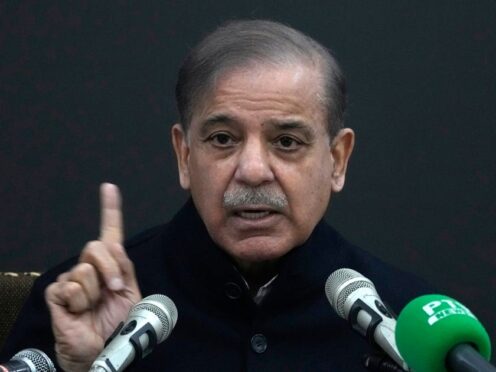
Pakistan’s National Assembly has elected Shehbaz Sharif as the country’s prime minister for the second time.
Allies of imprisoned former premier Imran Khan in parliament shouted in protest against his appointment, alleging rigging in last month’s election.
Speaker Ayaz Sadiq said Mr Sharif secured 201 votes, defeating Omar Ayub of the Sunni Ittehad Council who got 92 votes. Mr Sharif only needed 169 votes to get a majority.
Mr Ayub enjoyed the backing of Mr Khan’s Pakistan Tehreek-e-Insaf party, or PTI, whose candidates could not get enough seats to form a government on their own. The PTI refused to hold talks with its rivals to form a coalition.
Following days of negotiations, Mr Sharif’s Pakistan Muslim League party and his supporters formed an alliance after the February 8 election whose results were announced after an unusual delay because of a nationwide mobile phone outage.
Authorities said the cutting of communications was necessary to avoid militant attacks on candidates and security forces.

However, the delay drew criticism from Mr Khan’s party, which insists the vote was rigged to stop it from getting a majority.
The party claims it has evidence its victory “was stolen during the vote count” – a charge the Election Commission denies.
Mr Sharif’s government faces multiple challenges, including how to respond to a surge in militant attacks, fix the ailing economy, improve relations with neighbouring, Taliban-run Afghanistan, repair crumbling infrastructure, and resolve year-round power outages.
It must also maintain political stability as Mr Khan’s party has vowed to continue protests against the alleged vote-rigging.
Mr Khan, who is currently serving prison terms in multiple cases and has been barred from seeking or holding office, wrote a letter last week to the International Monetary Fund, urging it to link any talks with Islamabad to an audit of February’s election. That came days before the IMF releases a key instalment of a bailout loan to Pakistan.
Pakistan has been relying on bailouts to prop-up its foreign exchange reserves and avoid default, with the IMF and wealthy allies like China and Saudi Arabia financing the country to the tune of billions of pounds.
Mr Sharif replaced Mr Khan after he was ousted in a no-confidence vote in parliament in April 2022.
The new PM has said he will seek a fresh IMF bailout after the end of March when the current one expires.

Enjoy the convenience of having The Sunday Post delivered as a digital ePaper straight to your smartphone, tablet or computer.
Subscribe for only £5.49 a month and enjoy all the benefits of the printed paper as a digital replica.
Subscribe